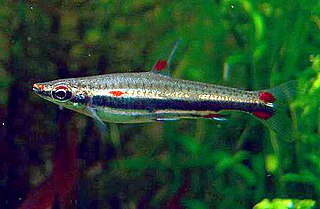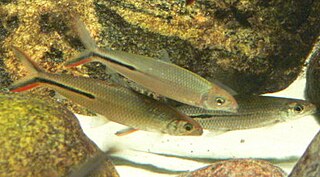
Characidae, the characids or characins is a family of freshwater subtropical and tropical fish, belonging to the order Characiformes. The name "characins" is the historical one, but scientists today tend to prefer "characids" to reflect their status as a by and large monophyletic group at family rank. To arrive there, this family has undergone much systematic and taxonomic change. Among those fishes that remain in the Characidae for the time being are the tetras, comprising the very similar genera Hemigrammus and Hyphessobrycon, as well as a few related forms such as the cave and neon tetras. Fish of this family are important as food and also include popular aquarium fish species.

Hyphessobrycon is a genus of freshwater fish in the family Characidae. These species are among the fishes known as tetras. The genus is distributed in the Neotropical realm from southern Mexico to Río de la Plata in Argentina. Many of these species are native to South America; about six species are from Central America and a single species, H. compressus is from southern Mexico.

Astyanax is a genus of freshwater fish in the family Characidae of the order Characiformes. Some of these fish, like many of their relatives, are kept as aquarium pets and known collectively as tetras. With around 150 described species and new ones being described yearly, this genus is among the largest of the entire order; Hyphessobrycon also has more than 145 species and which one is larger at any one time depends on whether more species have been recently described in one or the other. The blind and colorless cave tetra of Mexico is a famous member of the genus, but its taxonomic position is disputed: Some recognize it as part of the Mexican tetra and this is supported by phylogenetic evidence, but others recognize the cave form as a separate species, A. jordani.

Nannostomus is a genus of fish belonging to the characin family Lebiasinidae. All of the species in this genus are known as pencil fish, a popular name that was initially only applied to two species in the 1920s, Nannostomus unifasciatus and Nannostomus eques, by the late 1950s however, the term would be applied to all members of the genus. Several species have become popular aquarium fish due to their attractive coloration, unique shape, and interesting demeanor.

Leporinus is a genus of fish in the family Anostomidae native to South America. The fossil species Leporinus scalabrinii, known from the late Miocene of Entre Ríos in Argentina, has only recently been added to this genus after being misidentified as a species of primate under the name Arrhinolemur scalabrinii for over 100 years.

Copella is a genus of freshwater fish belonging to the family Lebiasinidae, native to South America, known colloquially to aquarists as splashing tetras or splash tetras, because of the unique reproductive method of the best-known representative of the genus, Copella arnoldi. They are not as closely related to the tetras proper in the Characidae as initially believed.

Moenkhausia is a genus of freshwater fish in the family Characidae native to tropical and subtropical South America. These are medium-sized tetras where the largest species only reach around 12 cm (4.7 in).

Bryconamericus is a genus of characins found in Central and South America.

Hemibrycon is a genus of characins. They are mainly found in South America, Trinidad in the Caribbean), and H. dariensis of east Panama.

Hemigrammus is a genus of freshwater fish in the family Characidae native to South America and commonly seen in the aquarium trade. These are medium-small tetras where the largest species reach up to around 11 cm (4.3 in).
Knodus is a genus of characins, small freshwater fish from South America.

Metynnis is a genus of serrasalmid fish from tropical and subtropical South America. They are herbivorous or omnivorous, and inhabit a wide range of freshwater habitats, ranging from rivers and streams, to floodplains, flooded forests, lakes, pools and reservoirs. They generally reach 8–15 cm (3–6 in) in standard length, although a few species may reach up to 18 cm (7 in). The genus contains many of the species known as silver dollars in the aquarium trade.
Odontostilbe is a genus of characins from tropical Central and South America, with 17 currently recognized species:
Serrapinnus is a genus of characins from tropical South America.

Characidium is a genus of fish in the family Crenuchidae. They are mainly found in South America, but C. marshi is from Panama. They are small, slender fish that live on the bottom in flowing fresh waters and feed on small animals such as insects.
Curimatopsis is a genus of small South American fish in the family Curimatidae. They are native to freshwater habitats in the Amazon, Orinoco and Paraguay basins, as well as river of the Guianas.
Steindachnerina is a genus of toothless characins from South America, with 24 currently described species:

Hemiodus is a genus of halftooths from South America with the greatest species richness in the Amazon Basin, but also found in the Orinoco, Essequibo, Paraná–Paraguay and Parnaíba River basins. Depending on the species involved, these elongate fish reach a length of 7–30 cm (3–12 in).
Nannostomus grandis is a freshwater species of fish belonging to the characin family Lebiasinidae. This species is closely related to Nannostomus beckfordi, being somewhat similar in coloration, but with a more elongated body. It has been described as the largest member of the genus; however, N. harrisoni consistently reaches a mature length in excess of 60 mm and is the more likely claimant for that distinction. It was only recently formally described by Zarske, although the author reports it probably had been assumed to be a form of N. beckfordi in the past and had even been exported for the aquarium trade at times. It is native to Brazil and currently has no accepted common name.

Copella arnoldi, commonly known as the splash tetra or the splashing tetra, is a species of tropical freshwater fish belonging to the family Lebiasinidae. It is native to South America.













